West Coast of the United States
The West Coast or Pacific Coast is the coastline along which the continental Western United States meets the North Pacific Ocean. As a region, this term most often refers to the coastal states of California, Oregon, Washington, and Alaska.[2][3][4][5][6][7] More specifically, it refers to an area defined on the east by the Alaska Range, Cascade Range, Sierra Nevada, and Mojave Desert, and on the west by the Pacific Ocean. The United States Census groups the five states of California, Oregon, Washington, Alaska, and Hawaii together as the Pacific States division.[8]
West Coast of the United States | |
|---|---|
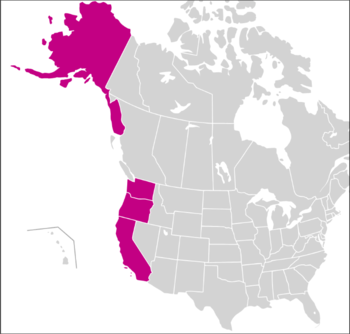 The states shown in purplish-red are included in the term West Coast or Pacific Coast. | |
| Population (2017 estimate) | |
| • Total | 51,085,172[1] |
| Time zones | UTC−8 (PST) |
| • Summer (DST) | UTC−7 (PDT) |
| UTC−9 (AKST) | |
| • Summer (DST) | UTC−8 (AKDT) |
Population
As of the 2010 Census, the estimated population of the Census Bureau's Pacific Region was approximately 47.8 million – about 15.3% of U.S. population.[9] The largest city on the west coast of the United States is Los Angeles.
Major cities
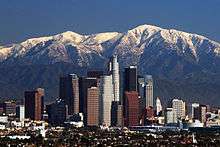
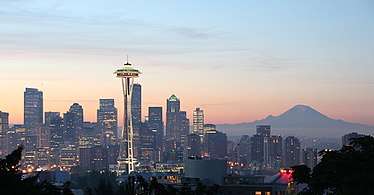
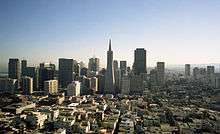
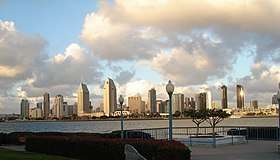
Of the cities and metropolitan areas on the West Coast, only Los Angeles, Long Beach, San Francisco, and San Diego are directly on the open Pacific Ocean. Major cities and metropolitan areas on the West Coast include (from north to south):
Washington
History
The history of the West Coast begins with the arrival of the earliest known humans of the Americas, Paleo-Indians, crossing the Bering Strait from Eurasia into North America over a land bridge, Beringia, that existed between 45,000 BCE and 12,000 BCE (47,000–14,000 years ago). Small isolated groups of hunter-gatherers migrated alongside herds of large herbivores far into Alaska. Between 16,500 BCE and 13,500 BCE (18,500–15,500 years ago), ice-free corridors developed along the Pacific coast and valleys of North America and possibly by sea.[10]
Alaska Natives, indigenous peoples of the Pacific Northwest Coast, and California indigenous peoples eventually descended from the Paleo-Indians. They developed various languages and established trade routes.
Later, Spanish, British, French, Russian, and American explorers and settlers began colonizing the area.
Climate
The West Coast of the United States has an oceanic climate in its Northwestern, Northern, and Eastern edge towards the U.S.-Canada border, but from the California border towards the U.S.-Mexico border the climate is mediterranean. The coastline sees significantly mild temperatures when compared to the inland areas during summer. In far Northern California there is a difference of 17 °C (30 °F) between Eureka and Willow Creek in spite of only 25 miles (40 km) separating the locations and Willow Creek being located at a 500 metres (1,600 ft) elevation. Slightly narrower fluctuations can be seen all through the coastline, and could partially be explained by the cold currents in the Pacific Ocean moderating coastal temperatures and the mountain ranges blocking the maritime air from moving farther inland than its foothills during summer. Coastal fog is also prevalent in keeping shoreline temperatures cool. This does not only occur in the San Francisco Bay Area, but it also affects Santa Monica in Los Angeles, Southern California, with very little yearly temperature differences but with cool summers similar to those expected in Northern Europe. A short journey inland and summer temperatures are comparable with the rest of the United States on the same latitudes, sometimes warmer due to prevailing winds from the Nevada and Arizona hot desert climate.
Culture
Since the West Coast has been populated by immigrants and their descendants more recently than the East Coast, its culture is considerably younger. Additionally, its demographic composition underlies its cultural difference from the rest of the United States. California's history first as a major Spanish colony, and later Mexican territory, has given the lower West Coast a distinctive Hispanic tone, which it also shares with the rest of the Southwest. Similarly, two of the three cities in which Asian Americans have concentrated, San Francisco and Los Angeles,[11][12][13] are located on the West Coast, with significant populations in other West Coast cities. San Francisco's Chinatown, the oldest in North America, is a noted cultural center.
The West Coast also has a proportionally large share of green cities within the United States, which manifests itself in different cultural practices such as bicycling and organic gardening.[14]
In the Pacific Northwest, Portland and Seattle are both considered among the coffee capitals of the world.[15] While Starbucks originated in Seattle, both cities are known for small-scale coffee roasters and independent coffeeshops. The culture has also been significantly shaped by the environment, especially by its forests, mountains, and rain. This may account for the fact that the Northwest has many high-quality libraries and bookshops (most notably Powell's Books and the Seattle Central Library) and a "bibliophile soul".[16] The region also has a marginal, but growing independence movement based on bioregionalism and a Cascadian identity.[17] The Cascadian flag has become a popular image at Seattle Sounders and Portland Timbers games.
Alaska is widely known for its outdoors and its inhabitants engage in a range of activities which are unique to the state. Some of these activities can be experienced through the state's annual events, such as the Iron Dog snowmobile race from Anchorage to Nome and on to Fairbanks. Other events include the World Ice Art Championships (Fairbanks) and the Sitka Whalefest (Sitka).
See also
References
| Wikivoyage has a travel guide for West Coast (United States of America). |
- "West Coast States 2020". Retrieved 2020-04-12.
- Victor Kiprop. "Which States Are On The West Coast? Four states are on the Western Pacific Coast of the United States". World Atlas.
- "Pacific Coast". Encyclopaedia Britannica.
- "the West Coast". Macmillan Dictionary.
- "West Coast". Cambridge Dictionary.
- Fodor's ... Cruises and Ports of Call. New York: Fodor's Travel Publications. 1995. p. 239. ISBN 978-0-679-02939-7.
- "World War II on the West Coast". Ancestry.com.
- "U. S. Census Regions and Divisions". U.S. Energy Information Administration. Archived from the original on August 17, 2000. Retrieved September 18, 2014.
- "United States Census Bureau, 2005 American Community Survey. Summed estimates for CA, OR, WA, AK, and HI". Factfinder.census.gov. Archived from the original on February 12, 2020. Retrieved October 18, 2012.
- "First Americans Endured 20,000-Year Layover – Jennifer Viegas, Discovery News". Retrieved 2009-11-18.
Archaeological evidence, in fact, recognizes that people started to leave Beringia for the New World around 40,000 years ago, but rapid expansion into North America did not occur until about 15,000 years ago, when the ice had literally broken.
- "Selected Population Profile in the United States". United States Census Bureau. United States Department of Commerce. Archived from the original on February 12, 2020. Retrieved June 25, 2011.
- Lee, Sharon M. (1998). "Asian Americans: Diverse and Growing" (PDF). Population Bulletin. Population Reference Bureau. 53 (2): 1–40. PMID 12321628. Retrieved March 9, 2013.
- Ng, Franklin (1998). The History and Immigration of Asian Americans. Taylor & Francis. p. 211. ISBN 978-0-8153-2690-8. Retrieved March 9, 2013.
- "Top ten green U.S. cities". Mother Nature Network. Retrieved June 26, 2014.
- "World's 10 best cities for coffee". USA Today. Retrieved February 22, 2015.
- "Pacific Northwest: bicycles, bookshops, weirdness and coffee". The Guardian. Retrieved February 22, 2015.
- "The People Who Wouldn't Mind if the Pacific Northwest Were Its Own Country". Vice. Retrieved February 22, 2015.